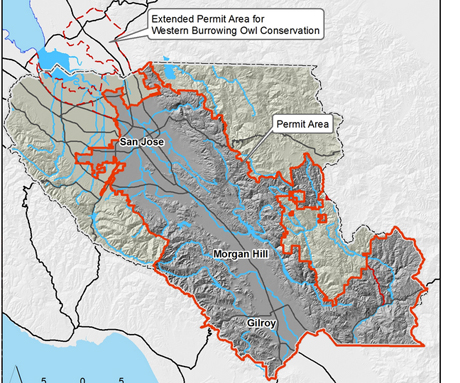Agencies in Santa Clara Valley have finalized a sweeping conservation plan that will set out guidelines for development in exchange for preserving South Bay creeks, trails and open space.
State, county and local agency leaders will meet Thursday morning at the Anderson Dam in Morgan Hill for a signing ceremony to launch the Santa Clara Valley Habitat Conservation Plan. The dam, which is due for a seismic upgrade, is one of several public projects that will be streamlined because of the new planning tool. The plan is managed by a joint powers agreement among the cities of San Jose, Gilroy and Morgan Hill, Santa Clara County, the Santa Clara Valley Transportation Authority and the Santa Clara Valley Water District.
Habitat conservation plans (HCPs) like these have been around since the early ‘80s, as extensions of the Endangered Species Act passed a decade earlier. An HCP is essentially a blueprint for future growth that ensures any development harming a listed endangered animal will be mitigated by preserving the larger habitat it relies on, contributing to the protection of the species as a whole, according to the U.S. Department of the Interior.
The local plan began in 2005, as part of state and federal approval of widening projects along Interstate 101. Under current rules, local governments have to evaluate projects case by case and involve a slew of government agencies, which takes a lot of time and money.
Once the new document is signed into existence this week, that process will be more streamlined. New rules spell out a system that gives local agencies authority to permit development that affects endangered species. Landowners and builders will know about their conservation obligations ahead of time, because they’re laid out instead of being decided per project.
“The current system also does less to protect wildlife because project-specific mitigation measures result in land being set aside on a piecemeal basis, resulting in fragmented habitats that are less ecologically viable and also more difficult to manage,” the joint powers agency explains on its FAQ page.
Under the new conservation plan, regional lands called “reserves” will be set aside for restoration. The HCP lays out how those reserves will be managed, to make sure the species aren’t just protected, but that they thrive. Some 46,920 acres are pegged for permanent protection.
Local protected species include:
Coyote Ceanothus
Metcalf Canyon Jewelflower
Least Bell’s Vireo
Western Burrowing Owl
Fragrant Fritillary
Tri-Colored Blackbird
Bay Checkerspot Butterfly
California Tiger Salamander
California Red Legged Frog
Coyote Ridge Anderson Lake
Foothill Yellow-legged Frog
Fox
Loma Prieta Hoita
Most Beautiful Jewelflower
Mt. Hamilton Thistle
Santa Clara Valley Dudleya
Smooth Lessingia
Tiburon Indian Paintbrush
Western Pond Turtle




